At first glance, golden barrel cactus (
Echinocactus grusonii) looks like a green ball covered in yellow fuzz. Its round shape and yellow spines add a touch of warm color to the arid landscape. This cactus is extremely versatile and can be used in both contemporary or more natural landscapes. This Mexican native thrives in hot, arid climates but can also be found growing in colder areas in greenhouses or in containers that are brought inside in winter. Golden barrel cacti are truly fuss-free plants that add beauty to arid gardens with little to no additional care needed except for watering every month or two in low-desert climates.
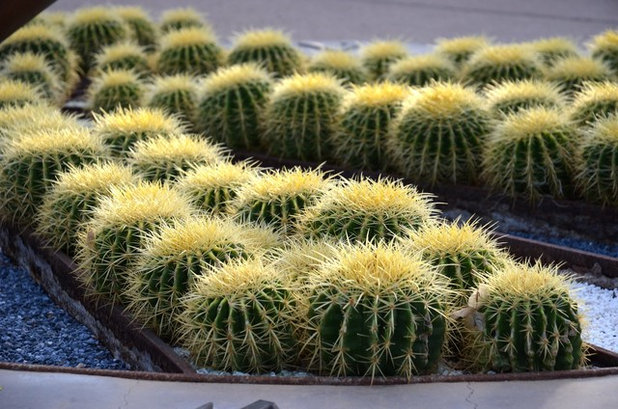
Noelle Johnson Landscape Consulting
Botanical name: Echinocactus grusoniiCommon names: Golden barrel cactus, mother-in-law’s cushion
Origin: Native to central Mexico, growing along rocky slopes at 4,000 feet; almost extinct in the wild — the golden barrel cacti used in the landscape today come from seeds from those grown in cultivation
Where it will grow: Hardy to 15 degrees Fahrenheit (USDA zone 8b; find your zone)
Water requirement: Drought tolerant, but established plants do best when watered twice a month in summer and every six weeks in winter
Light requirement: Full sun to filtered shade
Mature size: Up to 1 foot to 3 feet tall and 2 feet wide
Benefits and tolerances: Drought tolerant
When to plant: Fall or spring, from transplants or seed
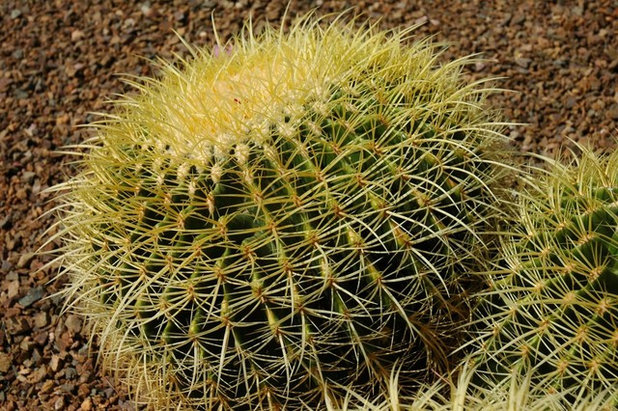
Noelle Johnson Landscape Consulting
Distinguishing traits. The overlapping, curved spines give this cactus a golden yellow appearance, especially when viewed from the top, while the green surface is more visible from the side. Mature specimens of golden barrel cacti can have up to 35 ribs, which expand and contract depending on the availability of water.
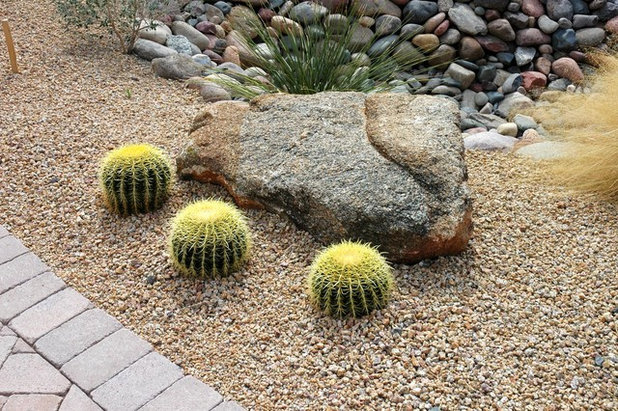
Noelle Johnson Landscape Consulting
Golden barrel cactus grows slowly in the landscape and can live up to 30 years or more. The spines of younger specimens are more prominent than those that are more mature, giving them a yellower appearance. Older cacti have more distinguished ribs and green color showing through the spines.
Yellow flowers emerge in spring from a yellow, woolly center at the top of the cactus and usually occur only with mature specimens (over 20 years old). Small, yellow fruits appear after the blooms have faded, containing seeds that can be planted.
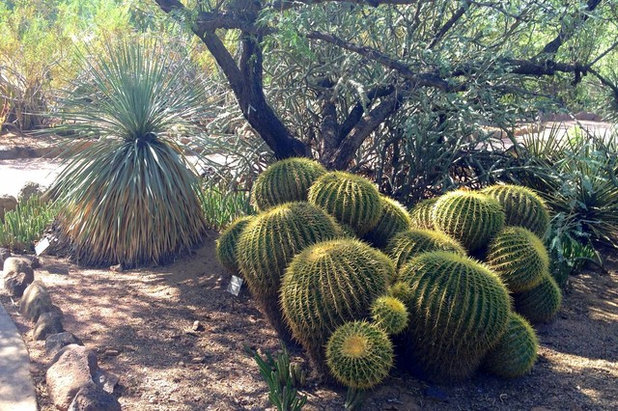
Noelle Johnson Landscape Consulting
While most golden barrel cacti grow singly, some produce multiple heads and grow in clusters, like the one seen here, at the Desert Botanical Garden in Phoenix.
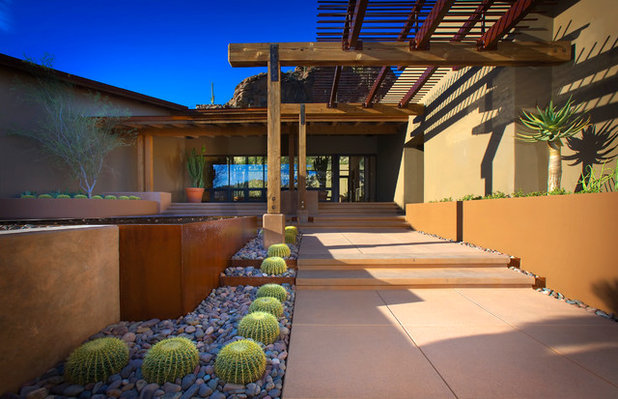
Bianchi Design
How to use it. The spherical shape of golden barrel cacti makes them a popular choice for modern landscape designs, where you can find them planted in straight or staggered rows, often along pathways.
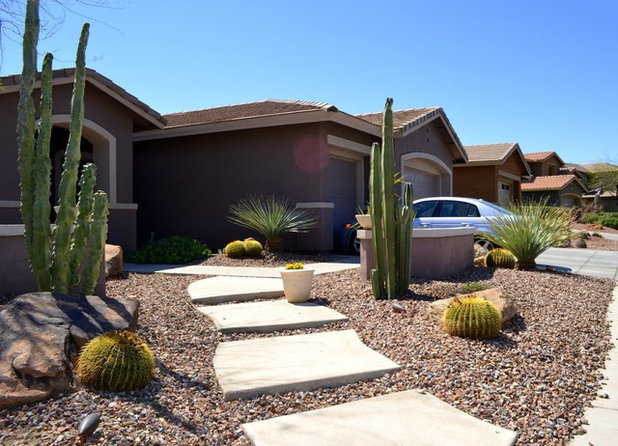
Noelle Johnson Landscape Consulting
This accent plant can stand on its own, but it also looks great combined with other plants, such as Baja fairy duster (
Calliandra californica), blackfoot daisy (
Melampodium leucanthum), desert ruellia (
Ruellia peninsularis) and
verbena (
Glandularia spp). Or pair it with other succulents, such as agave,
Blue Elf aloe (
Aloe ‘Blue Elf’) or
Mexican fence post (
Pachycereus marginatus).
In addition to contemporary landscapes, golden barrel also does well in more natural designs. Use it to anchor an entry by planting it next to a boulder — add a firecracker penstemon nearby for a great color contrast.
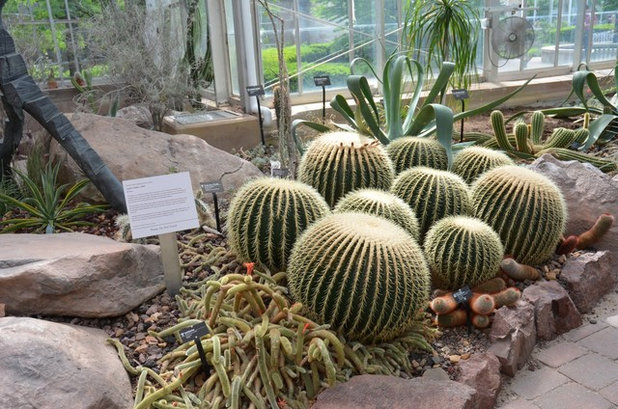
Noelle Johnson Landscape Consulting
Like many other succulents, golden barrel also makes a great container plant. Those who live in colder climates can grow this cactus year-round in greenhouses, or in the warmer months in containers outdoors, bringing them inside over winter to sit by a sunny window.
Shown: Golden barrel cacti growing in a greenhouse at the Frederik Meijer Gardens in Grand Rapids, Michigan
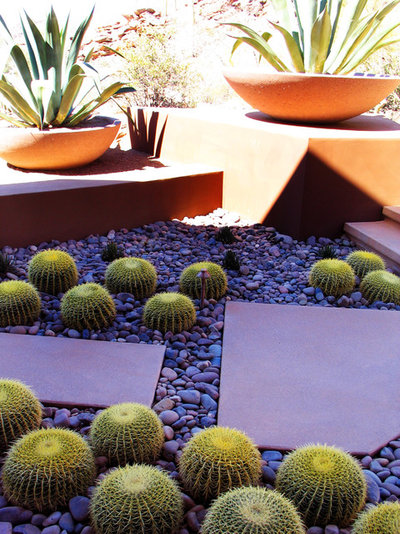
Bianchi Design
Planting notes. Wearing gloves, use an old towel, a carpet scrap or a plastic bag to handle the cacti when planting to avoid getting pricked by the thorns. Plant them in full sun or light, filtered shade. Provide temporary shade in areas with full sun for a couple of months to give the golden barrel time to acclimate to its new, sunny exposure — a patio chair works well. In low-desert climates, it’s best to avoid areas that receive hot, reflected sun.
While these cacti aren’t fussy about most things, they must have well-drained soil and prefer rocky soil, which mimics their native habitat. Use a planting mix specially formulated for succulents when planting them in containers.
Water newly planted golden barrel cacti once a week for the first month and, for them to do their best, once a week in the first summer.
More Houzz guides to growing succulents





